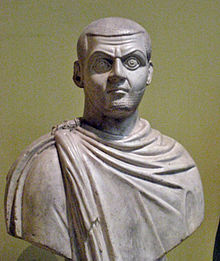Below, abridged translation from the first
volume of Karlheinz Deschner’s Kriminalgeschichte
des Christentums (Criminal History of Christianity)
Bust of Maximinus Daia
War against Maximinus II
Maximinus Daia was not a bad ruler. He knew how to manage and protect literature and science, despite being himself of humble origin and scarce culture. His persecutions against Christians, between 311 and 312, were quite moderate.
In February of 313 Constantine renewed in Milan the pact with Licinius, whom he married with his sister Constantia to endorse the agreement. In a constitution, the so-called Edict of Milan, both emperors granted legal status to Christianity, and with special reference to it they proclaimed freedom of worship throughout the empire.
If Maximinus were overthrown tolerance would extend to the eastern part, but all religions were already equated from the legal point of view. Maximinus, who built temples in all the cities and ordered the reconstruction of the ancient temples, and who protected the most notable pagan priests, guessed without difficulty what was coming. During the harsh winter of 312 to 313 he took advantage of an absence of Licinius to invade Syria. After conquering Byzantium and Heraclea, on April 30, 313 he confronted in the place called ‘Campus Serenus’ near Tzirallum an enemy that already had Christian symbols on its flags.
According to Father Lactantius, this already was a true war of religion, a judgement with which Johannes Geffcken coincides when he calls it ‘the first true war of religion in the world’. Licinius, to whom ‘an angel of the Lord’ had appeared in the eve of the day of the battle, made the soldiers take off their helmets to pray; his butchers ‘raised their hands to heaven’, invoked the name of God three times and then, ‘with hearts full of courage, they put on their helmets again and raised their shields’.
It was then that a miracle occurred, when ‘those few forces made a great slaughter’. The religion of love put to paint war stories! Maximinus was able to escape disguised as a slave in the direction of Nicomedia and then continued with his followers to Cilicia, passing the mountains of Taurus. The same year he died in Tarsus, suicidal or sick, while the troops of Licinius were advancing on the city by land and by sea.
The ‘good news’ had triumphed for the first time in all the Roman Empire and the other ‘enemies of God’, according to Eusebius, that is to say, the supporters of Maximinus Daia ‘were exterminated after long torments’, ‘especially those who, to flatter the sovereign, had persecuted our religion blinded by their arrogance’, the holy bishop congratulates himself.
Licinius, as Eduard Schwarz says, ‘documented his sympathy for the Church mainly through a tremendous blood bath, welcomed by Christians with great shouting of joy.’ There the women and children who had survived the performance of other emperors or caesars perished. Among the assassinated were Severianus, son of the emperor Severe (in turn, assassinated in 307), Candidianus, son of the emperor Galerius (that had been entrusted by the dying father to the trusteeship of Licinius); Prisca and Valeria were also murdered, and in the most brutal way, the wife and daughter of Diocletian along with Valeria’s children despite the supplications of the old emperor, who had already abdicated and who died that same year.
The wife of Maximinus Daia was also killed; an eight-year-old son and a seven-year-old daughter, Candidianus’ fiancée. And ‘also those who were proud of their kinship with the tyrant suffered the same fate, after great humiliations’, that is, entire families were exterminated and ‘the wicked were wiped from the face of the earth’ (Eusebius). Lactantius also comments that ‘the wicked received truly and justly, with God’s judgment, the payment of their actions’ and the whole world could see their fall and extermination, ‘until there was no trunk or roots left’.
